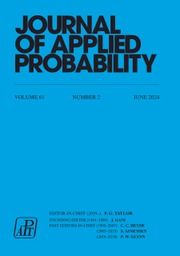No CrossRef data available.
Article contents
A note on subadditivity of value at risks (VaRs): A new connection to comonotonicity
Published online by Cambridge University Press: 18 September 2025
Abstract
In this paper, we provide a new property of value at risk (VaR), which is a standard risk measure that is widely used in quantitative financial risk management. We show that the subadditivity of VaR for given loss random variables holds for any confidence level if and only if those are comonotonic. This result also gives a new equivalent condition for the comonotonicity of random vectors.
MSC classification
Information
- Type
- Original Article
- Information
- Copyright
- © The Author(s), 2025. Published by Cambridge University Press on behalf of Applied Probability Trust
References
Cheung, K. C. (2008). Characterization of comonotonicity using convex order. Insurance Math. Econom. 43, 403–406.10.1016/j.insmatheco.2008.08.002CrossRefGoogle Scholar
Cheung, K. C. (2010). Characterizing a comonotonic random vector by the distribution of the sum of its components. Insurance Math. Econom. 47, 130–136.10.1016/j.insmatheco.2010.06.004CrossRefGoogle Scholar
Cuesta-Albertos, J. A., Rüschendorf, L. and Tuero-Diaz, A. (1993). Optimal coupling of multivariate distributions and stochastic processes. J. Multivariate Anal. 46, 335–361.10.1006/jmva.1993.1064CrossRefGoogle Scholar
Denuit, M., Dhaene, J., Ghossoub, M. and Robert, C. Y. (2025). Comonotonicity and Pareto optimality, with application to collaborative insurance. Insurance Math. Econom. 120, 1–16.10.1016/j.insmatheco.2024.11.001CrossRefGoogle Scholar
Dhaene, J., Denuit, M., Goovaerts, M. J., Kaas, R. and Vyncke, D. (2002). The concept of comonotonicity in actuarial science and finance: Theory. Insurance Math. Econom. 31, 3–33.10.1016/S0167-6687(02)00134-8CrossRefGoogle Scholar
Dhaene, J., Denuit, M., Goovaerts, M. J., Kaas, R. and Vyncke, D. (2002). The concept of comonotonicity in actuarial science and finance: Application. Insurance Math. Econom. 31, 133–161.10.1016/S0167-6687(02)00135-XCrossRefGoogle Scholar
Embrechts, P., McNeil, A. and Straumann, D. (1999). Correlation and dependency in risk management: Properties and pitfalls. In Value at Risk and Beyond, ed. M. Dempster, pp. 176–223. Cambridge University Press, Cambridge.Google Scholar
Föllmer, H. and Schied, A. (2016). Stochastic Finance: An Introduction in Discrete Time, 4th edn. De Gruyter, Berlin.Google Scholar
McNeil, A. J., Frey, R. and Embrechts, P. (2005). Quantitative Risk Management. Princeton University Press, Princeton.Google Scholar
Mao, T. and Hu, T. (2011). A new proof of Cheung’s characterization of comonotonicity. Insurance Math. Econom. 48, 214–216.10.1016/j.insmatheco.2010.11.003CrossRefGoogle Scholar


